Back to help and advice menu
Concrete underpinning vs GeoPoly: which one you should pick and why
If your house is suffering from subsidence, an engineer or builder might have offered concrete underpinning as a solution. While concrete underpinning still works and has worked for many decades, the reality is that there are other modern solutions available.
These newer, modern technologies can help stop your home from sinking for good while saving time and money. One of the most cost-effective and reliable is resin underpinning. Our resin underpinning solution, GeoPoly™, is the one we’d recommend over any other solution around. Why? Here are our top reasons.

Concrete underpinning can disrupt
With concrete underpinning, large holes need to be dug under your home. After those holes have been dug, they need to be filled with concrete.
This could take between a few weeks to a few months to complete, depending on the complexity of the concrete underpinning project.
For safety reasons, you can’t be at home while the digging takes place which means you need to take up residence elsewhere. If you can stay at a relative or friend’s home, you can save money. But staying in a temporary residence such as a hotel, motel or even an Airbnb could escalate your expenses.
Our resin underpinning solution doesn’t require that you vacate your home, even while we’re at work. GeoPoly™ can be injected under your home’s foundations to achieve true stability within just a few days.

Concrete underpinning can be pricey
The financial pressures that many Aussie homeowners experience can make the price tag of concrete underpinning less than appealing.
But due to the physical work and amount of materials required for concrete underpinning, the typical cost can be between $20,000 to $100,000. If your house happens to be a larger one, costs could go up further.
However, lifting and underpinning a sinking house with GeoPoly™ typically costs between $5,000 to $20,000 — a fraction of the price of concrete underpinning.

Concrete reduces in volume while curing
Cement-based products shrink while they cure. The curing process results in the release of water and in turn, a reduction in volume.
The same occurs when concrete is poured to underpin a house. As the concrete cures, small gaps will appear under the footings of a home. For stability, these gaps also need to be filled with more concrete. Naturally, this extra concrete also shrinks over time due to the release of water.
As cured concrete adjusts to the load bearing down from above, further settlement can occur and result in additional cracks. Some of these cracks mightn’t be repairable without adding more concrete.
GeoPoly™ doesn’t do this because it behaves in the opposite way to concrete. It expands instead of contracting. In fact, it can generate enough force to lift structures and resist heavy bearing loads within minutes.
Still considering underpinning? Stop right there.
If a builder or engineer has recommended concrete underpinning, it’s understandable that you’re considering it.
But before you go ahead, why not check out our resin underpinning solution, GeoPoly™? We know that it’s less disruptive, more affordable and we guarantee stability for up to 10 years.
If you’d like to know more about resin underpinning and GeoPoly™, we’d be happy to tell you more or give your home a FREE inspection.
Just give us a call on 1300 854 115 or book a FREE inspection today


























